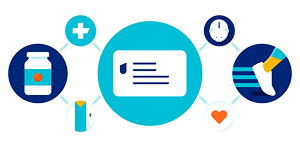- Where can I shop for health insurance?
- When can I shop for insurance?
- What costs should I look at when shopping for insurance?
- How can I tell what’s covered?
- Can I get help paying for my insurance?
- Where can I get help with shopping for insurance?
- Where can I shop for supplemental insurance, such as dental and vision?
If you have health insurance, you may get it through your employer or buy it on the federal Health Insurance Marketplace. That’s a government-run website where you can buy health plans.
When you get health insurance through your employer, choosing a plan is simple. You’ll have just a few plans to consider (if that many), and someone from your human resources department will walk you through the process. If you have further questions, you can even get in touch with a representative from the health insurance company.
Buying health insurance on the federal Health Insurance Marketplace is a bit different — and more complicated. We’re here to help you make the best decision for you, so you can take care of your physical — and financial — well-being.
If you have a job that offers health insurance benefits, you may have to pay a certain amount per year for your benefits. So, you really don’t need to shop for a plan.
ut if you don’t have a job or an employer that offers health insurance, you may have to shop for your own. One way to do that is by buying a health insurance plan online through a health insurance marketplace or “exchange.” There, you’ll find health plans governed by the Affordable Care Act (ACA), sometimes called Obamacare. Another way? You can enter your ZIP code to search available plans or call a licensed agent at 1-844-211-7730.
ACA plans, which are offered by private insurers like UnitedHealthcare, must abide by certain rules. For example, they can’t exclude you if you have preexisting conditions. They also offer essential benefits such as:
- Children’s health care, including dental and vision care
- Emergency care
- Hospitalization (such as surgery and overnight stays)
- Laboratory tests
- Mental health and substance use disorder care
- Outpatient care
- Pregnancy, maternity and newborn care
- Prescription drugs
- Preventive and wellness services and chronic disease management
- Rehabilitative services and devices
The U.S. government runs the federal Health Insurance Marketplace. About a third of the states (along with the District of Columbia) run their own marketplaces, but don’t worry if you aren’t sure where to shop in your state. When you log in to the federal Health Insurance Marketplace, it will either lead you to use the federal Marketplace or your state’s website, notes Noor Ali, M.D., a health insurance consultant in Tampa, Florida.
When shopping for an ACA health plan on a health insurance marketplace, you’ll enter your ZIP code and some other basic information. Then you’ll get a list of all the plans from all the insurers who serve your county. That makes comparison shopping easy.
You don’t have to shop for an ACA plan on the federal Health Insurance Marketplace or your state’s exchange. You can also buy an ACA plan directly from an insurance company. For example, you can browse ACA plans on uhone.com. You can also call a licensed agent at 1-844-211-7730 for personalized assistance. Shopping on a company’s site means you can browse other supplemental insurance offerings as well, such as dental and vision insurance, which are not included in an ACA plan.
What ACA metal level should I choose?
When you’re shopping for an ACA plan on the Marketplace, you’ll notice that the plans are labeled by “metal” categories: bronze, silver, gold and platinum. That doesn’t mean a platinum plan is the best and a bronze plan is the worst. They all offer comparable coverage.
Instead, the metal category represents how you and your insurance company will share costs. Bronze plans have the lowest premiums, but your insurance company pays a smaller portion (60%) of your medical bills. They also have higher deductible.
Platinum plans, on the other hand, have the highest premiums, but your insurance company pays 90% of your bills, and you usually have a lower deductible.
“The lower the metal tier, the higher the deductible, which means you’re paying less on premiums now,” says Dr. Ali. “But you’re going to be hit with bigger out-of-pocket costs if and when something goes wrong.”
Which metal level you choose will depend on what premium you can afford and how much care you’re likely to need. “Everybody’s got different health issues,” says insurance agent Jeff Schneider of Louisville, Kentucky. “A good plan for you is not going to be a good fit for me.”
There are usually specific times when you are able to buy a health insurance plan. If you get your insurance through your employer, you’ll likely have an enrollment window during which you can sign up for benefits. Talk to your human resources person about when it takes place. You’ll likely only have a certain window in which to sign up.
For ACA plans, you’ll have to wait until the annual Open Enrollment Period, which normally runs from November 1 to January 15 each year. For example, if you enroll by December 15, coverage starts on January 1 of the new year. If you enroll after December 15, it starts on February 1.
Some state marketplaces have slightly different Open Enrollment Periods. For example, California’s Open Enrollment Period runs from November 1 to January 31, while Idaho’s runs from October 15 to December 15. Check your state’s exchange website. You’ll be able to find out when the next Open Enrollment period is and how long it’s open.
If you miss Open Enrollment, it doesn’t mean you can’t get health insurance. For example, you may be eligible for a Special Enrollment Period, or SEP. To qualify for an SEP, you must have experienced a qualified life event in the last 60 days that affected your health insurance needs (or expect to experience a qualified life event in the next 60 days). Examples include:
- Becoming a U.S. citizen
- Changes in income that affect your eligibility for coverage
- Changes in your household, such as getting married, a death in the family, having a baby or adopting a child
- Leaving jail or prison
- Losing your insurance coverage
- Moving to a different ZIP code or county
- Starting or ending service with AmeriCorps
Even if you don’t qualify for an SEP, you can still get health insurance. For example, you may qualify for a short term health plan. Short term health insurance provides temporary coverage, and the duration varies by plan and state.
But keep in mind that short term health insurance plans are not governed by the ACA, so what they cover may vary. And your application may be reviewed by an underwriter. That means you could be denied coverage or charged more depending on certain aspects of your current health status.
One great thing about short term plans is that you don’t have to wait for an Open Enrollment Period to sign up for them. You can typically apply for a short term health plan at any time. Interested in short term health insurance? Get more details now or call a licensed agent at 1-844-211-7730 to discuss your options.
When you’re shopping for an insurance plan, it’s important to choose a plan that fits your budget. That might be different from person to person. So, if you ask your neighbor what type of plan they have, know that their choice might not be the best one for you.
For each plan you’re considering, you’ll want to consider these numbers:
- Premium: This is the monthly bill you’ll pay to keep your health insurance coverage.
- Deductible: This is how much you must pay out of pocket before your insurance plan pays the rest; note that some services, such as preventive care, may be covered before you meet your deductible.
- Out-of-pocket maximum: This is the most you will have to pay out of pocket each plan year.
- Copayment (or copay): This is a fixed-dollar cost share you pay when you receive a health service or fill a prescription.
- Coinsurance: This is a percentage cost share you pay when you receive a health service or fill a prescription.
To find the right plan for you, you’ll need to find a balance between what you’ll pay each month to have your plan and how much you’ll have to pay when you get care. A lower premium plan may save you money each month, but you’ll likely pay more out of pocket for care when you get it.
While it can be tempting to just focus on premiums, that may not get you the right plan, says Schneider. “It’s no different than buying a car,” he says. “People buy on price, and they don’t really understand the car.”
Dr. Ali agrees. “You can have an amazing plan that covers you head to toe, but if it costs $4,000 a month, and you simply can’t afford it, that’s meaningless,” she says.
Dr. Ali recommends focusing first on the premium, then on the deductible, and finally on the actual coverage you’ll receive. “I would argue that the deductible is often even more important than the premium, because that’s going to dictate when you’ll actually be using your plan,” she says.
The out-of-pocket maximum is worth paying attention to as well. In a worst-case scenario — say, a car accident or a cancer diagnosis — you know that it’s the most you’ll have to pay for your care in a given year.
Ready to explore insurance plans where you live?
Your insurance company has to provide you with a Summary of Benefits and Coverage (SBC) that outlines the costs and coverages of a plan. You’ll want to compare SBCs from different plans as you’re shopping.
Consider these 3 aspects of a plan’s coverage:
- The plan’s covered services
- The plan’s network
- The plan’s formulary (drug list)
Let’s start with covered services. If you’re buying an ACA plan, you’ll automatically have coverage for 10 essential health benefits, including preventive care, prescription drugs and hospitalization. ACA plans also cover dental and vision care for kids — but not for adults. (Adults need separate plans for dental and vision care — more on that later.)
Next is the plan’s network. Most insurance plans have a designated network of providers and health care facilities that you can go to for care. If you have certain providers or facilities that you prefer to go to, you’ll want to make sure they are in your chosen plan’s network.
You can look at the plan’s provider directory or simply call their billing offices and ask. “That might be a faster way, rather than poring through the directory and making sure you have updated information,” Dr. Ali says. Another easy option: Explore your options now or contact a licensed agent at 1-844-211-7730. They can help you find a plan that covers your preferred providers.
You’ll also want to consider the type of network. With an HMO (health maintenance organization) network, you may only have coverage when you use in-network providers and facilities. With a PPO (preferred provider organization) network, you may use any provider or facility across the country. But you’ll have to pay more for your care if the provider is not in the network.
“Probably 5% of my customers ever asked me about network, but network is one of the biggest parts of health insurance,” says Schneider.
Finally, if you take any prescription medicines, you’ll want to review the plan’s formulary. This is the list of drugs that your plan covers. Prescription drugs are usually grouped into 4 or 5 tiers; the lower the tier, the less you’ll pay at the pharmacy counter. If a medication you take isn’t covered, you’ll have to pay for it yourself or ask your doctor whether another medication would work instead.
Yes, there are 2 types of financial assistance available for ACA plans: premium tax credits and cost-sharing reductions. Whether you qualify depends on where you live, how many people are in your household and what your household income is.
Premium tax credit
If you qualify for a premium tax credit, you’ll pay a lower premium each month. How much you’ll save depends on your income. Note that if your income or household size changes, your tax credit will probably change. (You’ll reconcile your tax credit when you file your federal income tax return.)
To qualify, your household income must be between 100% and 400% of the federal poverty level (for 2023, that’s up to $54,360 for an individual). However, people above that level may qualify for premium tax credits through 2025. That’s thanks to a COVID relief policy that was extended by the 2022 Inflation Reduction Act.
Cost-sharing reductions
If you qualify for cost-sharing reductions, you’ll pay less out of pocket when you receive care. Specifically, you’ll have a lower deductible, a lower out-of-pocket maximum and lower copays and coinsurance.
Cost-sharing reductions are only available for silver ACA plans (tax credits are available for any metal level plan). The income limit to qualify is also lower than for tax credits — your household income must be between 100% and 250% of the federal poverty level (for 2023, that’s up to $33,975 for an individual).
You may need help figuring out how to shop for insurance, because it can be pretty confusing. “There’s a lot of industry technical jargon,” Dr. Ali says. “And it’s very easy to make the wrong decision — or not even make a decision — on health insurance, because you don’t know what to choose.”
Fortunately, help is available. These professionals can answer your questions and even enroll you in a health plan at no extra cost to you:
-
Agents and brokers: These individuals are licensed in their states and represent 1 or more insurance companies whose plans they sell. Agents typically work for a single health insurance company; brokers typically represent several companies.
Agents and brokers can offer personalized recommendations based on your needs and budget. They can also help you shop for supplemental insurance plans such as dental and vision. And their work doesn’t end when you buy your plan. They can also act as an advocate for you if you ever have a problem with your insurance company.
Best of all, you do not have to pay to work with an agent or broker. They are paid by the insurance companies whose plans they sell. You can start working with a licensed agent today by calling 1-844-211-7730. Explore your options now.
-
Assisters and navigators: These trained individuals provide unbiased advice and often work for nonprofit organizations. They can help you navigate the marketplace and fill out paperwork for financial assistance and plan applications. However, they cannot provide personalized advice about choosing a plan or act as an advocate for you.
Assistance from agents, brokers and navigators is free and can be a huge help when you’re shopping for insurance. “I don’t know why anybody would go into the marketplace and not consult with somebody,” Schneider says.
Signing up for a health insurance plan is the first step toward getting your health care needs covered. But there’s additional coverage that you might want to consider.
For example, many employed-based insurance plans don’t offer dental or vision insurance. And most ACA plans don’t cover dental and vision care for adults.
But regular dental cleanings and exams and vision checkups are important for staying healthy. And if you need contacts or glasses, vision coverage can help you pay for those each year.
It’s worth knowing that some ACA plans come with dental insurance. You can also shop for a separate dental plan on the marketplace, but you can only buy one at the same time that you’re buying your health plan. (You can also explore your options now or call a licensed agent at 1-844-211-7730 to discuss your options.) Vision insurance is not available on the marketplace, but it is here: Take a glance at the benefits and compare with confidence or contact a licensed agent at 1-844-211-7730.
Another option is to buy dental and vision insurance directly from an insurance company. There’s usually no enrollment — you can sign up for a plan at any time. You may even be able to bundle your dental and vision coverage to save money.
You can shop for dental and vision insurance by calling a licensed insurance agent at 1-844-211-7730. Got questions on insurance bundles? Get more details on vision and dental insurance now.
There are other supplemental insurance plans that can help cover your costs in case of catastrophic illness, injury and death. Other supplement plans you may want to look into include:
- Accident insurance helps cover the cost of injuries, such as broken bones, and emergency room visits.
- Critical illness insurance pays a lump-sum cash benefit if you experience a qualifying illness such as heart attack, stroke or cancer diagnosis.
- Hospital and doctor insurance pays a set amount for certain medical services such as doctor visits, surgeries or prescriptions.
Not sure if you need a supplemental plan? Get more details now or call a licensed agent at 1-844-211-7730 to discuss your options.
Sources
Covered California. “Apply for Coverage.” Retrieved from https://www.coveredca.com/support/before-you-buy/enrollment-dates-and-deadlines/ Accessed May 25, 2023
Georgetown University Health Policy Institute: Center for Children and Families. “What’s New for 2023 Marketplace Enrollment?” October 3, 2022. Retrieved from https://ccf.georgetown.edu/2022/10/03/whats-new-for-2023-marketplace-enrollment/
Georgetown University McCourt School of Public Policy. “Federal Poverty Level.” Retrieved from https://navigatorguide.georgetown.edu/federal-poverty-level Accessed June 8, 2023
Georgetown University McCourt School of Public Policy. “I can’t afford to pay much for deductibles and co-pays. Is there help for me in the marketplace for cost-sharing?” Retrieved from https://navigatorguide.georgetown.edu/faq/i-cant-afford-to-pay-much-for-deductibles-and-co-pays-is-there-help-for-me-in-the-marketplace-for-cost-sharing Accessed May 25, 2023
HealthCare.gov. “Agent and broker (health insurance).” Retrieved from https://www.healthcare.gov/glossary/agent/ Accessed May 25, 2023
HealthCare.gov. “Cost-sharing reductions.” Retrieved from https://www.healthcare.gov/lower-costs/save-on-out-of-pocket-costs/ Accessed May 25, 2023
HealthCare.gov. “Coverage for pre-existing Conditions.” Retrieved from https://www.healthcare.gov/coverage/pre-existing-conditions/ Accessed May 25, 2023
HealthCare.gov. “Dental coverage in the Marketplace.” Retrieved from https://www.healthcare.gov/coverage/dental-coverage/ Accessed May 25, 2023
HealthCare.gov. “Enroll in or change 2023 plans — only with a Special Enrollment Period.” Retrieved from https://www.healthcare.gov/coverage-outside-open-enrollment/special-enrollment-period/ Accessed May 25, 2023
HealthCare.gov. “How to save on your monthly insurance bill with a premium tax credit.” Retrieved from https://www.healthcare.gov/lower-costs/save-on-monthly-premiums/ Accessed May 25, 2023
HealthCare.gov. “The health plan categories: Bronze, Silver, Gold & Platinum.” Retrieved from https://www.healthcare.gov/choose-a-plan/plans-categories/ Accessed May 25, 2023
HealthCare.gov. “The Marketplace in your state.” Retrieved from https://www.healthcare.gov/marketplace-in-your-state/ Accessed May 25, 2023
HealthCare.gov. “What Marketplace health insurance plans cover.” Retrieved from https://www.healthcare.gov/coverage/what-marketplace-plans-cover/ Accessed May 25, 2023
Your Health Idaho. “Open Enrollment for 2023 Health Insurance Begins October 15,” October 14, 2022. Retrieved from https://www.yourhealthidaho.org/open-enrollment-for-2023-health-insurance-begins-october-15/
Compliance code
49888-X-0923











